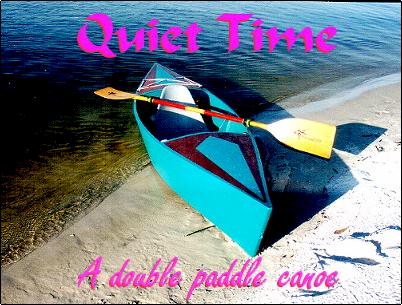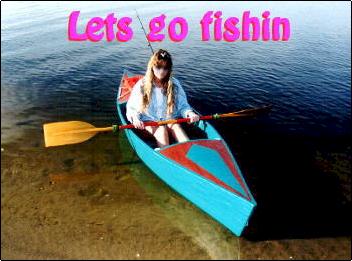During the summer of 2001 my sweetie and I decided to build our
first stitch and glue boat (Cynthia) - a small, lightweight rowing pram
for use in and around Florida's less accessible shallow water mangrove
areas. Cynthia and our latest vessel "Quiet Time" (the double paddle,
decked canoe), were both built using a boat construction method known as
"stitch and tape"
 also
known as "stitch and glue" construction. We learned of this type of boat
building on the Internet. Just about any Internet search engine will come
up with lots of web sites that explain this boat building method. There
are also books on this method of boat construction. Stitch and tape/
stitch and glue construction = inexpensive, simple, fast, forgiving, and
durable. An excellent way to build your first boat! We can't say enough
good things about our experiences with this technique! also
known as "stitch and glue" construction. We learned of this type of boat
building on the Internet. Just about any Internet search engine will come
up with lots of web sites that explain this boat building method. There
are also books on this method of boat construction. Stitch and tape/
stitch and glue construction = inexpensive, simple, fast, forgiving, and
durable. An excellent way to build your first boat! We can't say enough
good things about our experiences with this technique!
Anyway back to the story. Our first home built boat "Cynthia",
a little rowing pram turned out to be quite comfortable for one adult but
not so for two. We needed a second boat. Actually we had so much fun
building and rowing the first boat that we decided to try our hand at
building a second. For our second boat we decided to build a "double
paddle canoe". We wanted this vessel to be able to travel the same
shallow/hidden waters that Cynthia was capable of. It was also important
to have this new boat be easy and quick to get to the water. At 10 feet 4
inches long and 30 inches wide we have no need to tie this 35-pound decked
canoe to a roof rack. It fits easily inside of our conversion van. Our
decked canoe design is loosely based on a type of boat known as a Cajun
Pirogue and more closely based on a design by Fritz Funk known as a "Wacky
Lassie". We drew up our own version because we needed a specific
length and maximum freeboard to accommodate our needs. We finished
construction in just 10 leisurely days (lots of time spent waiting for
resin and glue to cure). We covered the entire hull exterior with one
layer of 7-ounce fiberglass cloth.
 The
hull panels and decks were cut from two 4' by 8' sheets of 1/4 inch Luann
plywood ($10 a sheet at Home Depot). We used 1/2" CDX plywood scrap for
the two bulkheads and the center rib. The bow and stern stems were cut
from 2"x 2" douglas fir. Two 3/4" x 3/4" inwales were cut from a 12'
douglas fir 1" x 2". We purchased a $7.00 molded plastic boat seat from
Wal-Mart. These inexpensive seats are very lightweight and very
comfortable! The boat is painted with an oil-based paint. The decks have
been stained with an oil-based stain and top coated with spar varnish.
We've got less than $150. Invested in this boat. The
hull panels and decks were cut from two 4' by 8' sheets of 1/4 inch Luann
plywood ($10 a sheet at Home Depot). We used 1/2" CDX plywood scrap for
the two bulkheads and the center rib. The bow and stern stems were cut
from 2"x 2" douglas fir. Two 3/4" x 3/4" inwales were cut from a 12'
douglas fir 1" x 2". We purchased a $7.00 molded plastic boat seat from
Wal-Mart. These inexpensive seats are very lightweight and very
comfortable! The boat is painted with an oil-based paint. The decks have
been stained with an oil-based stain and top coated with spar varnish.
We've got less than $150. Invested in this boat.
Our little decked canoe paddles well for such a short boat. The
bottom has only two inches of rocker built in. We figured that some would
be beneficial but we still wanted to keep the bow and stern in the water
to maximize displacement potential and keep the boat tracking well. It's
been a strong little boat. Excellent for fishing and exploring the ponds,
mangroves, and inshore saltwater flats of Southwest Florida. |